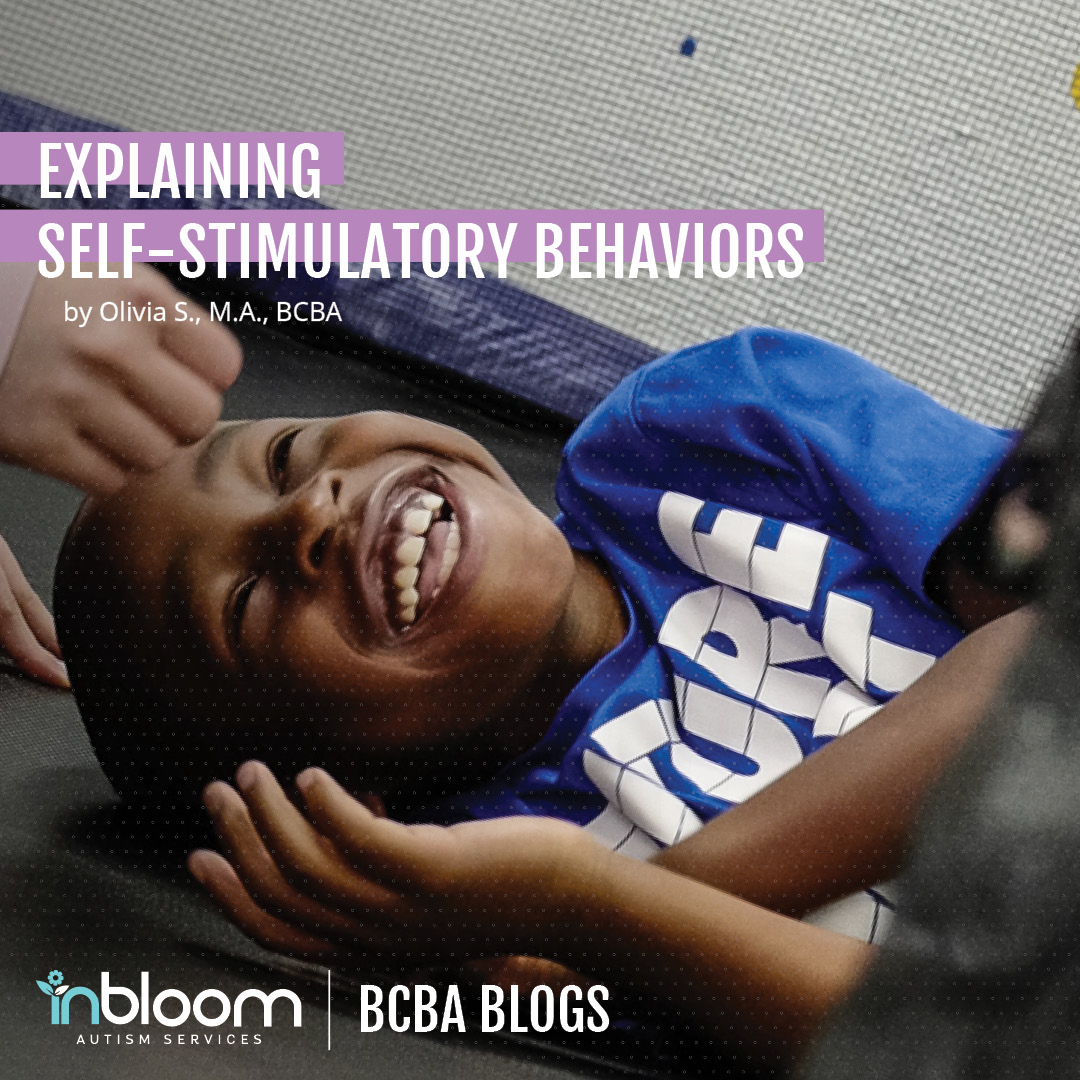Explaining ‘Stimming’ or Self-Stimulatory Behaviors

As humans, all of our behaviors occur for 4 main reasons or functions: to gain access to something, to escape or avoid something, to gain attention from someone, or because they feel good. For the last category of behaviors, we refer to them as self-stimulatory behaviors– they are also referred to as ‘stimming.’ This means they are behaviors we engage in that stimulate our senses or make us feel good inside. They include things that we enjoy looking at, things we enjoy smelling, things that give us oral stimulation, or things that physically feel good.
The Truth About Stimming
We all have self-stimulatory behaviors. They are not unique to someone diagnosed with Autism Spectrum Disorders (ASD), even though someone diagnosed with Autism may do them at a higher frequency than those without ASD. We all enjoy receiving sensory input in our unique ways. Engaging in self-stimulatory behavior is very enjoyable and can even be very calming, so it isn’t uncommon to see an increase in self-stimulatory behavior when we are nervous or upset.
Self-stimulatory behaviors are often unique to each individual, meaning that what feels good to one person may not feel as good to someone else. However, there are some common ones out there. These include twirling your hair, shaking your foot/leg, chewing gum, or fidgeting with jewelry. Individuals with ASD may engage in different topographies (i.e. forms) than those without ASD. Those topographies may include looking at items from a certain angle, putting things in their mouths, smelling things that are not intended to be smelled, or persistent hand flapping.
Self-stimulatory behaviors can also be perseverative behaviors with a specific interest or topic. For instance, someone may be insistent on watching all of the movies in a specific series over and over, reading the same book repetitively, or talking about the same topic with their friends. Some perseverative interests could also include obtaining things/doing things that involve a preferred character or wearing clothes with a certain type of fabric.
Stimming and Autism
When individuals with ASD engage in self-stimulatory behaviors, we should not automatically assume that we need to reduce those behaviors. As stated previously, everyone engages in these behaviors.
Did you know that InBloom’s ABA therapy programs can also include a focus on learning readiness skills? Call 888-754-0398 or speak to your child’s InBloom BCBA!
As a general rule, if the self-stimulatory does not prevent the individual from learning, engaging socially in their environments, or being safe, we should allow the individual to continue to engage in that behavior. Even if the topography of the self-stimulatory behavior appears different, such as flapping your hands repetitively or making certain sounds- as long as the individual can still learn, engage socially, and be safe, then it is not disruptive and should therefore not be reduced.
However, some self-stimulatory behaviors need to be decreased since they prevent the child from learning, engaging socially, or being safe. An individual who engages in loud vocalizations repetitively misses learning opportunities since they cannot hear others. Someone who perseverates on orange may not be able to engage with peers if they are (or are not) wearing orange. Someone who puts things in their mouth for oral stimulation may cut themselves or get ill often.
If you are wondering if the self-stimulatory behavior needs to be decreased, observe your child engaging in it and see if it prevents them from learning, engaging socially, or being safe. If the answer is yes then the behavior needs to be decreased.
Decreasing Potentially Harmful Behaviors
Self-stimulatory behaviors will not go away on their own. Since they feel good to do, telling someone to stop will likely not be enough. To reduce a self-stimulatory behavior, we either need to teach the individual to do something else that feels good that is more appropriate, or teach the individual to regulate that behavior by only engaging in that behavior in a specific environment. Generally speaking, if you would like to replace the self-stimulatory behavior, try first to see if you can pick a behavior that involves the same sense.
- For instance, if a child mouths items, try to replace their item with a chewie, chewing gum, or snack foods that might provide the preferred sensation (e.g. baby carrots, pretzel rods, etc.). If this is not possible, you can always select a behavior that utilizes a different sense, but keep in mind that it may take longer to teach the child to do that behavior instead of their original self-stimulatory behavior.
If the self-stimulatory behavior needs to only be reduced in specific environments, you can teach the child to go to the appropriate environment to do that behavior. Like if it is socially inappropriate for a child to rock back and forth in their seat in the classroom, they could learn to ask to go to another part of the room where they can rock back and forth.
Next Steps
Don’t forget, if there’s a behavior you can’t quite figure out the function of, or if you’re concerned that behavior may disrupt your child’s life, talk with your child’s BCBA and RBT. Together, you can work on a plan that will give your child the tools to live their best life! The main thing to remember with self-stimulatory behaviors is that we all want to feel good and we all do things to feel good. Our self-stimulatory behaviors keep us happy and allow us to feel good in our skin, even in situations that can make us nervous or upset. Just because a self-stimulatory behavior looks atypical does not mean it needs to stop happening. Everyone deserves to feel good in their skin!
Written by: Olivia S. – M.A., BCBA
InBloom Autism Services specializes in early intervention ABA Therapy. Our Therapists undergo training to develop a curriculum specifically designed for children aged 5 and under with autism. Our Learning Centers also offer a safe and enjoyable environment for children to interact with their peers. Learn more about our ABA Therapy program!
Related Articles:
The Positive Effects of ABA Therapy for Children with Autism



